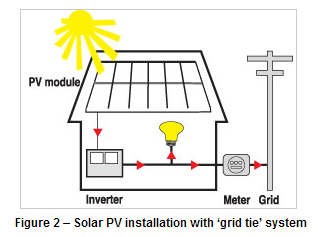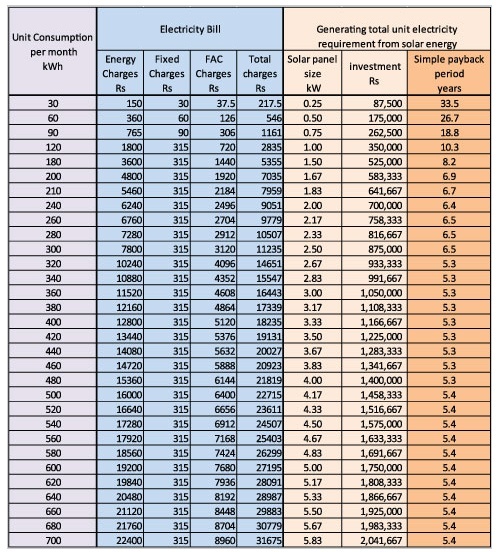An overview of the state of Solar PV installation in the Sri Lankan hotel industry was carried out recently by the SWITCH-Asia Greening Sri Lanka Hotels programme project team. While doing this study, the project team also analysed the impact of the proposed electricity increases on domestic Solar PV installations as well. A ready reckoner feasibility chart for evaluating financial feasibility of Solar PV installations for residences was also prepared. The following paper discusses these aspects.
Introduction
Of late, there has been much discussion about the generation of electricity from solar energy. This is usually called solar photovoltaic generation (Solar PV), where an array of solar cells, typically mounted on the roof of a building, will capture the solar energy and transform it to electrical energy.
In a conventional or standalone system, the solar electricity has to be stored, since usage (demand) does not always coincide with supply (generation). Hence, in a typical installation, electricity is generated in the form of direct current (DC) and usually stored in batteries. The size of such battery banks required will depend on the size of the installation and the days for which the system can operate on battery power alone, with no input from other generation sources.
In addition, the system requires an inverter to convert the electricity stored in the battery in the form of direct current (DC), to alternate current (AC) at a higher voltage, to be compatible with the downstream installation. The cost of a battery bank can be as much as a Solar PV panel for a well-designed system, which can provide power for several days when the Solar PV is not generating electricity. Batteries are still in the development stage and they are prone to premature failure. So, it is common that in Solar PV installations with a battery bank, some of the batteries have to be replaced before the specified lifetime.
Cost of installation
The high cost of Solar PV panels and the large amount of batteries required for storage resulted in the cost of such installations being prohibitively high and not feasible for installation as alternate energy sources.

With rapidly increasing electricity rates, reduction in price of Solar PV panels and acceptance by the Ceylon Electricity Board (CEB) to trade electricity units with the grid, Solar PV installations are at present becoming more financially attractive.
‘Trading’ of electricity
This ‘trading’ of electricity units, recently allowed by the CEB, is referred to as net metering or grid tie. This is where an electricity consumer is able to generate electricity at the consumer’s own premises, using any form of alternate energy source and can then synchronize the electricity thus produced with the CEB system and ‘export’ it to the CEB.

The consumer is not paid for this ‘exported’ electricity but is given credit (in kWh), which is set off against his normal electricity consumption off the grid. There will be metering for consumption as well for export of energy to the CEB network.
Each month, consumption and export of energy will be compared. If the export is more than the consumption, credit is given (in kWh). If consumption is higher than export, the consumer is charged for net amount of consumption (consumption - export).
This is effectively a ‘win-win’ situation for both the consumer and the electricity service provider (the CEB or LECO). The consumer benefits by being able to export the electricity he generates without having to store it, thereby reducing the need and the cost for a storage battery bank.
From the CEB’s/LECO’s point of view, there is some form of electricity demand reduction from the grid, since the consumer is now producing some quantum of electrical energy.

At present, the cost of investing in a grid tie Solar PV is around Rs.350,000 per kW and the cost of investing in a conventional Solar PV system is around Rs.700,000.
Solar PV installation in hotel industry
In spite of grid tie options being available, the reduction in cost of Solar PV panels and increased cost of electricity, Solar PV for larger industrial applications is still not financially attractive, due to the long pay back periods of around 15 years for a grid tied system and around 30 years for standalone systems.
Hence, from the surveys and studies carried out by the SWITCH-Asia Greening Sri Lanka Hotels programme, it has been found that Solar PV installation in hotels is still few and far between. In fact, from the 350 odd hotels working with the Greening Hotels programme, there are only three hotels, which have some form of Solar PV installations.
Ulagalla Resort
This 80 roomed resort hotel in Anuradhapura has been the trailblazer in taking a bold step in installing the largest Solar PV system in a hotel so far. It has a bank of Solar PV panels covering 900 sqms, generating 120 KW of electrical energy, which amounts to about 40 percent of the hotel’s total electrical demand.
The system operates on a net metering platform and cost about Rs.125 million for the entire installation, which was done with the commissioning of the hotel in 2010. While certainly the hotel has taken a bold and pioneering step in having such a large Solar PV installation, payback periods are still quite high.
 [/url
[/urlHowever, the hotel has been able to market this unique installation to give it a strong identity as a hotel which embraces good sustainable consumption practices.
Jetwing Sea and Jetwing Blue
When the former Jetwing Seashell Hotel was refurbished and relaunched as Jetwing Sea, a self-contained (inclusive of battery bank) Solar PV was installed for one wing of the guest rooms in the hotel. The installation cost was about Rs.12 million in 2010 and generates approximately 15 kW.
Former Jetwing Blue Oceanic was also refurbished and relaunched in the same year as Jetwing Blue and a Solar PV system, similar to Jetwing Sea was installed of capacity 20 kW, at a cost of Rs.16 million.
More than being a financial consideration, here again, it has become a unique selling proposition (USP) and a powerful marketing tool. The hotel proudly advertises itself that most of its rooms’ electrical energy is powered by the sun and each room has an indicator to show when the room is powered by solar (green light) and when it is powered by the mains, during low sunlight periods (red light).
Hence, other than for selective marketing and differentiating propositions, currently, larger Solar PV installations, either grid tied or standalone systems do not seem to be that viable in large scale hotel applications.
Solar PV for residences
However, with the rapid increase in electricity rates for residential buildings which consume higher loads, grid tie Solar PV installations are becoming a very much more feasible option.
Provided adequate roof area or space on the ground is available, any residence utilizing more than 300 units of electricity (kWh) per month, with the grid tie Solar PV installation at current cost and new electricity rates (which are being proposed), will pay back in just about less than six years.
The project has developed a ready reckoner, which gives a quick approximate indication of the financial feasibility of a Solar PV installation for residences.
It is evident from the table below, which shows the co-relation of payback periods for Solar PV installations and units consumed, it is evident that the moment a domestic consumer exceeds the lower thresholds of consumption of around 250 units, the effective electricity charges increase exponentially, bringing the payback period rapidly down to seven years and less.
(Srilal Miththapala, an Electrical Engineer by profession and a senior tourism professional and Suranga Karavita, a Mechanical Engineer, are Project Director and Industry Technical Services Manager of EU SWITCH-ASIA Programme Greening Sri Lanka Hotels project implemented by Ceylon Chamber of Commerce respectively)
http://www.dailymirror.lk/business/features/27390-feasibility-of-solar-electricity-in-sri-lanka-.html
 would enable you to enjoy an array of other services such as Member Rankings, User Groups, Own Posts & Profile, Exclusive Research, Live Chat Box etc..
would enable you to enjoy an array of other services such as Member Rankings, User Groups, Own Posts & Profile, Exclusive Research, Live Chat Box etc.. 
 Home
Home



















